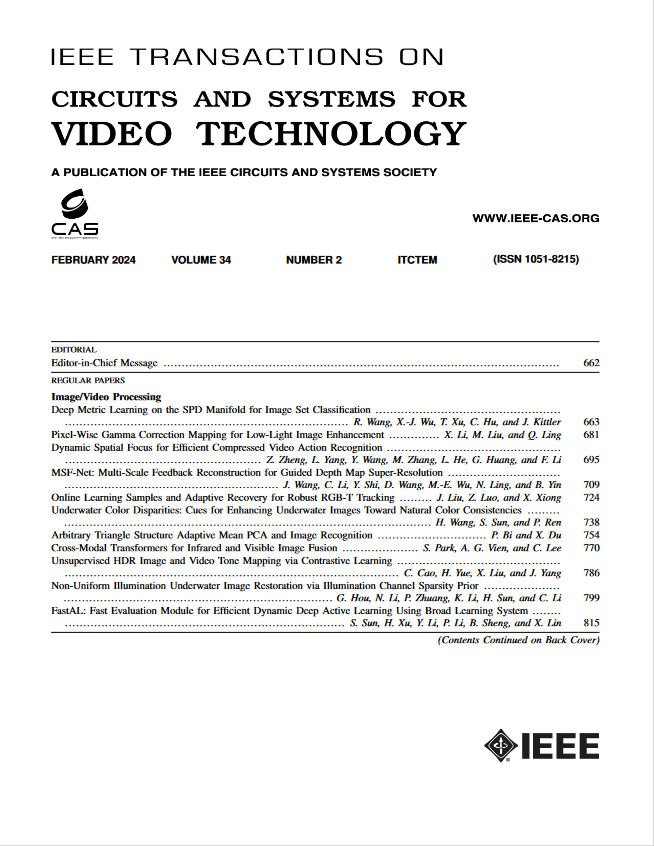更好的合身:适应不同的服装类型的虚拟试穿
IF 8.3
1区 工程技术
Q1 ENGINEERING, ELECTRICAL & ELECTRONIC
IEEE Transactions on Circuits and Systems for Video Technology
Pub Date : 2024-12-23
DOI:10.1109/TCSVT.2024.3521299
引用次数: 0
摘要
基于图像的虚拟试衣旨在将店内目标服装转换为已穿的模特形象,其目的是在完全脱去原服装的同时保留试衣区以外的内容,自然地穿着目标服装,正确地填补目标服装与原服装之间的差距。为了促进这一热门研究领域的发展,人们付出了巨大的努力,但却无法保持目标服装的类型与试穿区受原服装的影响。本文主要研究模型上的目标服装与原服装不配对的虚拟试衣情况,即实际场景。为了打破试穿区域与原始服装之间的相关性,使模型学习到正确的信息进行上色,我们提出了一种动态调整训练面具的自适应面具训练范式。它不仅提高了服装的对齐度和合身度,而且显著提高了虚拟试穿体验的保真度。在此基础上,首次提出了语义密度比(semantic - dense - ratio, SDR)和骨架密度比(Skeleton-LPIPS, S-LPIPS)两种非配对试衣评价指标,用于评价服装类型的正确性和服装纹理的准确性。对于非配对试穿验证,我们构建了一个具有不同服装项目和模特体型的综合交叉试穿基准(Cross-27),涵盖了广泛的试穿场景。实验证明了所提出方法的有效性,为虚拟试戴技术的发展做出了贡献,并为该领域的未来研究提供了新的见解和工具。代码、模型和基准将会公开发布。本文章由计算机程序翻译,如有差异,请以英文原文为准。
Better Fit: Accommodate Variations in Clothing Types for Virtual Try-On
Image-based virtual try-on aims to transfer target in-shop clothing to a dressed model image, the objectives of which are totally taking off original clothing while preserving the contents outside of the try-on area, naturally wearing target clothing and correctly inpainting the gap between target clothing and original clothing. Tremendous efforts have been made to facilitate this popular research area, but cannot keep the type of target clothing with the try-on area affected by original clothing. In this paper, we focus on the unpaired virtual try-on situation where target clothing and original clothing on the model are different, i.e., the practical scenario. To break the correlation between the try-on area and the original clothing and make the model learn the correct information to inpaint, we propose an adaptive mask training paradigm that dynamically adjusts training masks. It not only improves the alignment and fit of clothing but also significantly enhances the fidelity of virtual try-on experience. Furthermore, we for the first time propose two metrics for unpaired try-on evaluation, the Semantic-Densepose-Ratio (SDR) and Skeleton-LPIPS (S-LPIPS), to evaluate the correctness of clothing type and the accuracy of clothing texture. For unpaired try-on validation, we construct a comprehensive cross-try-on benchmark (Cross-27) with distinctive clothing items and model physiques, covering a broad try-on scenarios. Experiments demonstrate the effectiveness of the proposed methods, contributing to the advancement of virtual try-on technology and offering new insights and tools for future research in the field. The code, model and benchmark will be publicly released.
求助全文
通过发布文献求助,成功后即可免费获取论文全文。
去求助
来源期刊
CiteScore
13.80
自引率
27.40%
发文量
660
审稿时长
5 months
期刊介绍:
The IEEE Transactions on Circuits and Systems for Video Technology (TCSVT) is dedicated to covering all aspects of video technologies from a circuits and systems perspective. We encourage submissions of general, theoretical, and application-oriented papers related to image and video acquisition, representation, presentation, and display. Additionally, we welcome contributions in areas such as processing, filtering, and transforms; analysis and synthesis; learning and understanding; compression, transmission, communication, and networking; as well as storage, retrieval, indexing, and search. Furthermore, papers focusing on hardware and software design and implementation are highly valued. Join us in advancing the field of video technology through innovative research and insights.

 求助内容:
求助内容: 应助结果提醒方式:
应助结果提醒方式:


